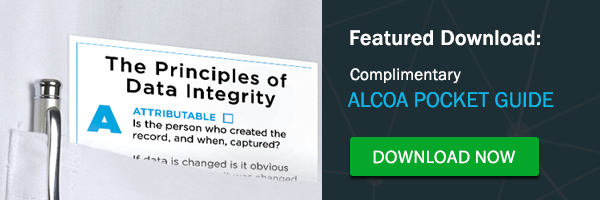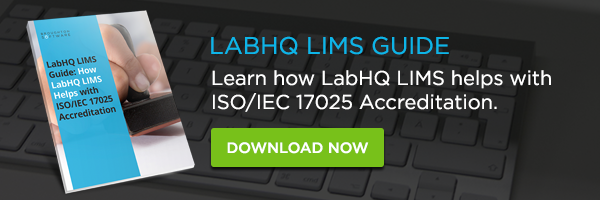
Laboratories look to gain ISO 17025 accreditation as recognition of their competence and abilities, to help them improve and monitor their operational processes, and to satisfy customer requirements. At the end of 2017, an update to the ISO 17025 standard was issued. In this blog, we give you an overview of what the standard is, what’s changed, and how computerised systems such as LIMS fits within the scope of the new standard.
What is ISO/IEC 17025 and Who Uses It?
ISO/IEC 17025:2017 is a publication of the general requirements for the competence of testing and calibration laboratories. Accreditation to this standard formally recognizes a laboratory’s aptitude, impartiality and consistent operation on a global scale.
Gaining ISO/IEC 17025 accreditation enables a laboratory to demonstrate these practices and expresses the confidence that ISO has in the work of that laboratory. ISO/IEC 17025 was developed by laboratory experts along with many other laboratory associations and the standard can be used by any laboratory wanting to demonstrate their capability to deliver accurate results and the methods with which they do so.
ISO/IEC 17025 not only demonstrates the laboratory’s ability to deliver and prove consistent, accurate and reliable results, it also enables laboratories to be able to assuredly share these results, ultimately creating a reputation of confidence and trust between laboratories and their customers.
How Has ISO/IEC 17025 Changed?
The transition from ISO/IEC 17025:2005 to 2017 has been given just over two years for publication and throughout this time both versions of the standard will be valid. Table 1 below shows a transition timeline by UKAS for laboratories who are looking to remain in compliance with the standard.
Table 1. ISO/IEC 17025:2017 Transition Dates
|
UKAS Transition timeline |
|
|
UKAS to begin offering assessments against ISO/IEC 17025:2017 |
01 March 2018 |
|
Laboratories have the option of assessment against either ISO/IEC 17025:2005 or ISO/IEC 17025:2017 |
01 March 2018 to 31 May 2019 |
|
All assessments to be conducted against ISO/IEC 17025:2017 |
01 June 2019 to 31 May 2020 |
|
Completion of transition assessments |
31 May 2020 |
|
Accreditation to ISO/IEC 17025:2005 ceases to be valid |
30 November 2020 |
Source: https://www.ukas.com/customer-area/isoiec-170252017-transition/
There are several changes that have been made as of 2017 and there are several reasons behind these changes. As well as changes in the structure of the standard itself and updating new terminologies, the key areas of change are the extensive areas covering more laboratory testing and calibration. The focus of the standard itself is around results rather than the methods used which brings it more in line with other ISO standards.
Here are a couple of short video introductions to the new standard released by ISO.
- Discover the new ISO/IEC 17025:2017
- Standard for the testing and calibration of labs under revision | Main changes
In addition to these changes, there is also more focus on computer technologies as a result of many laboratories transitioning from paper-based systems to electronic systems such as LIMS (Laboratory Information Management Systems).
LIMS and ISO/IEC 17025
One of the main reasons behind the changes to the standard is a stronger focus on information technologies in recognition that laboratories are moving away from paper and switching to much more reliable and efficient computer systems to assist in the production of electronic results and reports. A LIMS system has the ability to make life easier for a laboratory by making complex, lengthy and manual processes such as the production of Certificates of Analysis (in compliant formats) readily available with a single mouse click.
Data and Quality Assurance
From a laboratory perspective, using a LIMS gives opportunities to improve the way in which they deliver their services by mitigating the risks associated with a poor result. Having the ability to flag out of specification results allows for investigations to start immediately. This gives laboratories the ability to fully investigate the poor result as well as meet turnaround requirements of the client.
Providing test data is required to prove a laboratory’s competency against the standard. LIMS software helps produce evidence of your competency in various ways. Not only does a LIMS store all your data and specifications, giving you a clear history of all data, but it can also produce audit trails, prove the validity of test methods, trend your data and go above and beyond to give you an accurate trail of what you have tested, how, why, when and by whom (the ALCOA principle).
Employee Training and Competence
An important aspect of ISO/IEC 17025 is having the ability to prove employee competence. LIMS can help with this in a variety of ways. First, every analyst has work assigned to them in their own workbook, meaning that there is always evidence of who has done what. This is also true of the audit trails which has the user’s name against it and every test or movement of that sample. Each user account requires a password, and therefore access prevents employees from using alternative accounts. Employees may also carry out calibrations and competency tests that LIMS can import directly from equipment, so there is reduced human error and lower risk of manipulation. This data is stored and can be compared against specifications and historical test data to prove the competence of each employee. When a laboratory is looking to gain a highly technical accreditation to the ISO/IEC 17025 standard, they must be able to prove that employees can use the equipment, carry out tests and deliver accurate test results which is exactly where LIMS can help through features such as roles and permissions.
Equipment Integration and Testing
LIMS can integrate with your equipment which means that test results will import directly into the software. From there, results can be compared against configured specifications and historical test results. The move away from paper-based systems has been essential for those laboratories looking to reduce the risk of human error and manipulation through improved data storage and control which ultimately helps laboratories gain ISO/IEC 17025 accreditation.







